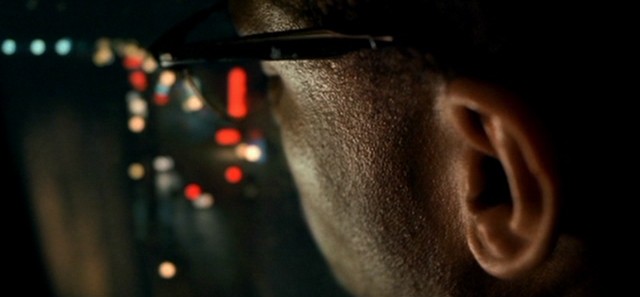It’s for a good reason that biopics are frequently looked down upon as the redheaded stepchild of cinema. Generally (until a good one comes out), they’re overly reverential, bathing its subject in warm light as they overcome their demons from childhood to death. It’s an easy structure, bending the facts into a middlebrow pretzel so that the audience is guaranteed to feel good by the end. Michael Mann’s Ali came out several years before the likes of Ray or Walk the Line or Get On Up, but it might as well be a direct reaction to the typical cradle-to-grave biopics. Nowhere in the film is this better emphasized than in its first ten minutes.
The first image we get is the obvious studio logo, but with a twist. We see the Columbia logo in its glory, and then it runs backwards, ushering the viewer from a full view of the statue directly into her torch’s light. On the soundtrack, we hear crowd noises, and then the announcement that Sam Cooke will be performing. But what follows isn’t some polished Cooke studio recording, what we get is an actor playing as Cooke, and performing as Cooke during a live show, complete with talk to the audience and long instrumental breaks. We haven’t even seen any images yet, and the sequence’s statement is clear; the past will be made contemporary. We get another example of this immediately afterwards. Our first glimpse of the title character (played convincingly by Will Smith), he is jogging through the streets. What makes this seemingly ordinary shot unusual is that it is shot on a digital camera. Not the sleek, film-like digital cameras of today, or even the darkness-piercing cameras Mann used on Collateral, but the fuzzy, noisy digital of 2001, when the format was still in its very infancy (the look is more Full Frontal than Attack of the Clones). Digital shots like these are dispersed throughout. Mann is subconsciously telling the viewer with each transition from film to digital that this is not a museum piece. But even the many sequences shot on good old 35mm feel strikingly modern. The movie is shot almost entirely handheld, which would get distracting if it wasn’t lensed by, for my money, the best handheld guy in the business, Emmanuel Lubezki. The camera is almost never at rest, exploring the (often confined) spaces of the film. In the ring, we frequently cut to shots where the camera is placed on the back of the actors’ heads. In this way, this film feels almost like a warm-up for Soderbergh’s work on The Knick, which uses digital cameras, handheld photography, and music in much of the same way, to give the show a modernist feel even when the subject feels prehistoric (you have to wonder if Soderbergh watched this film on a loop where developing The Knick). And at this point, the sequence is barely even a minute over.
We see Ali training for his match against Sonny Liston. When the camera settles down to observe a view of Ali (then Cassius Clay)’s eyes as he pummels on a speed bag (his eyes being visible pretty much every other frame), that’s when the flashbacks start. But far from the all-encompassing flashbacks of most biopics, here we get sketches of flashbacks. We get two scenes from Clay’s childhood. In one, his father (Giancarlo Esposito) paints a mural featuring a white Jesus while Clay looks on with a look of almost-confusion. This lasts maybe ten or fifteen seconds. In the other, Clay and his father board a segregated bus. The second scene is one you’d probably expect to see in most biopics about an African-American figure, but here, Mann once again plays it differently. We hear no dialogue from anyone on the bus, and other than the “Coloreds Only” sign, there are no period markers whatsoever or “pretty” lighting (perhaps it helps that Lubezki was born and raised in Mexico until the 90s, the images here have a lack of reverence that had to come from an outsider of sorts). This might as well be the bus you rode to work today. Mann is effectively brushing off the dust of history, making it new through filmmaking alone. By this point, the credits have finished, passing by almost unnoticed, but the sequence is not even half over. All the while, Sam Cooke is still performing, and Mann keeps cutting back to him in the club, seemingly completely detached from the other action. We get a more conventional flashback, where Clay attends a speech by Malcolm X, but that’s over and done with in 30 seconds. In maybe three minutes worth of flashbacks in a 165-minute-long movie, we have established the technique, the backstory, and Ali’s motivation. And the sequence is still going, and Cooke is still performing. The end of the 10-minute sequence is marked by Clay taunting Sonny Liston with many of his most famous sayings (the one about butterflies and bees, for example), but he’s saying them so fast and in such a procession that you’d be forgiven for missing more than one. There’s no explanation for the sayings, they’ve just been willed into existence seemingly at that moment. Just like the present, history resists any kind of explanation.

